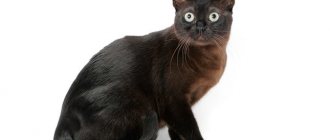Thousands of years side by side with man
Until recently, scientists believed that the domestication of cats began nine and a half thousand years ago. However, a groundbreaking new study published in the journal Science theorizes that the history and origins of cats as human companions goes back much further, to about 12,000 years ago. After analyzing the genes of 79 domestic cats and their wild ancestors, scientists concluded that modern cats descended from the same species: Felis silvestris (wild cat). Their domestication occurred in the Middle East in the Fertile Crescent region along the Tigris and Euphrates rivers, which includes Iraq, Israel and Lebanon.
It is known that many peoples have worshiped cats for thousands of years, considering them royal animals, adorning them with expensive necklaces and even mummifying them after death. The ancient Egyptians elevated cats to a cult and revered them as sacred animals (the most famous is the cat goddess Bastet). Apparently, this is why our furry beauties expect our complete worship.
According to David Zaks, writing for Smithsonian, the importance of this revised timeline is that it highlights that cats have been helping people for almost as long as dogs, just in a different capacity.
Interesting facts about the process of domesticating cats
- Genetic analysis was carried out on 30 ancient remains and 209 cats from three continents;
- In Egypt, cats began to live at temples and were adored by the clergy, since it was there that the main grain reserves were stored. In the Middle East, gentle predators were also highly valued because they protected manuscripts;
- The remains of 5,300-year-old cats have been found in China. This time is considered the second period of domestication. The researchers found that the bones belonged to a Bengal cat, which at that time was in the early stages of domestication. But over time, the descendants of the steppe species nevertheless supplanted the Bengal ones, since they were more sociable and obedient;
- For a long time, the wild color of cats remained unchanged. Only in the 14th century AD. the stripes began to “blur” into spots. Perhaps there was no need to pay attention to the appearance of the pets; the main thing that was valued was their affectionate nature and hunting skills;
- Wild cats continued to live for a long time next to domesticated cats near human settlements, constantly exchanging genetic material. Therefore, there are no significant changes in our domestic pets compared to wild individuals;
- One of the few changes that happened to cats during the process of domestication was a change in their voice to one that was as pleasant as possible to the human ear;
- “Cats domesticated themselves,” says researcher Carlos Driscoll about how the cat was domesticated.
- Cats were brought to Russian territory by sailors in the pre-Christian era (the cat was considered to accompany the pagan god Veles). The oldest remains date back to the 2nd century AD. Until the end of the Middle Ages, cats were considered a valuable commodity - their price was no less than for an adult healthy ox and was equal to 205 grams of silver. It was forbidden to kill them - this would result in a heavy fine or replacement of the cat with another;
- In Rus', only cats were allowed to enter churches - they saved the bins from the invasion of mice, for which they earned the patronage of the priests. But cats began to live directly in peasant huts only closer to the 18th century.
Still wild
As Gwynne Guilford writes in The Atlantic, cat genome expert Wes Warren explains that “cats, unlike dogs, are only half domesticated.” According to Warren, the domestication of cats began with the transition of humans to an agricultural society. It was a win-win situation. Farmers needed cats to keep rodents away from their barns, and cats needed a reliable source of food, which came from captured rodents and treats from farmers.
So, feed the cat and he will become your friend forever?
Maybe it won't, says Guilford. As cat genome studies confirm, one of the main differences in the domestication of dogs and cats is that the latter did not become completely dependent on humans for food. “Cats have retained the widest acoustic range of all predators, allowing them to hear the movements of their prey,” the author writes. “They have not lost the ability to see at night and digest foods rich in proteins and fats.” So, despite the fact that cats prefer ready-made food presented by a person, if necessary, they can go and hunt.
When did we become friends?
One would think that archaeological evidence would make it easy to understand when cats were domesticated, but wild cats and domesticated cats have remarkably similar skeletons, complicating research. On the island of Cyprus in 1983, archaeologists discovered the jawbone of a cat that was about 8,000 years old. Since it seemed unlikely that humans would have brought wild cats to the island not yet accustomed to humans, the discovery suggests that domestication occurred even earlier.
In 2004, the discovery of an even more ancient site in Cyprus, in which a cat was deliberately buried with a person, made it even more certain that the island's ancient cats were domesticated earlier, pushing domestication back another 1,500 years.
Not everyone likes cats
The history of cats contains several examples of "cool" attitudes, especially in the Middle Ages. Although their outstanding hunting skills made them popular animals, some were wary of their unerring and silent attack on prey. Some peoples even declared cats to be “devilish” animals. And the impossibility of complete domestication also, of course, played against them.
This wary attitude towards furry creatures continued during the era of witch hunts in America - not the best time to be born a cat! For example, black cats were unfairly considered vicious creatures that help their owners in dark affairs. Unfortunately, this superstition still exists, but more and more people are convinced that black cats are no worse than their relatives of other colors. Fortunately, even in those dark times, not everyone hated these graceful animals. As previously noted, farmers and villagers appreciated their good work in hunting mice, which kept the barns stocked. And in monasteries they were kept as pets.
In fact, according to the BBC, most of the legendary animals lived in medieval England. A young man named Richard (Dick) Whittington came to London looking for work. He bought a cat to get rid of mice in his attic room. One day, a wealthy merchant for whom Whittington worked invited his servants to earn extra money by sending some goods for sale on a ship sailing to overseas countries. Whittington had nothing to give except a cat. Fortunately for him, she caught all the rats on the ship, and when the ship landed on the shores of an overseas country, her king bought Whittington’s cat for a lot of money. Despite the fact that the story about Dick Whittington has no confirmation, this cat became the most famous in England.
Spots and stripes on fur
Wild and domestic cats had no significant differences in their genetic structure, and one of the few traits available to differentiate them was their coat markings.
The study sheds light on the late appearance of spotted or tabby coats, which began appearing in domestic solid-colored cats in the Middle Ages. The gene for the striped coat dates back to the Ottoman Empire in Southwest Asia and later became common in Europe and Africa.
However, it was not until the 18th century that markings became common enough to be associated with domestic cats, and in the 19th century, cat fanciers began selecting cats with special traits to create unusual breeds.
Modern cats
World leaders with an affinity for cats played a role in turning these animals into beloved pets. Winston Churchill, British Prime Minister during World War II and an animal lover, famously kept pets at his Chartwell country estate and at his official residence. In America, the first cats in the White House were Abraham Lincoln's favorites, Tabby and Dixie. It is said that President Lincoln loved cats so much that he even picked up stray animals during his presidential term in Washington.
Although you're unlikely to find a police cat or a rescue cat, they help modern society more than you might think, largely due to their top-notch hunting instincts. Cats were even “drafted” into the army to preserve food from rodents and, accordingly, save soldiers from hunger and disease, reports the PetMD portal.
Reflecting on the long and rich history of cats as pets, one question cannot be answered: did humans domesticate cats, or did they choose to live with humans? Both questions can be answered in the affirmative. There is a special bond between cat owners and their pets, and people who love cats happily worship their four-legged friends because the love they receive in return makes their hard work (and persistence) worth it.
How was it with us...?
In Christian communities, the cat was considered a child of evil, who was associated with magical rituals. The largest number of superstitions are attached to black cats. The extermination of these animals became the key to the proliferation of rodents in many countries, especially rats - the worst pests and carriers of the plague, which spread in Eurasia in the middle of the 19th century. Subsequently, the reputation of cats, which were called regulators of rodent numbers, was again restored.
If cats had not been destroyed in this way in the Middle Ages, who knows, maybe there would not have been a plague
Cats were brought to Russia from Western and Southern countries. Evidence of this is the excavations of the remains of the X-XIV centuries. In Rus', the cat was considered the keeper of the hearth.
If you find an error, please select a piece of text and press Ctrl+Enter.
Where did domestic cats come from?
According to scientists, the main contenders for the role of the ancestors of all cats are the small ancient mammals miacids, which appeared on Earth more than 40 million years ago. These small animals were predators and excellent tree climbers. According to one version, the ancestor of modern pets is the Libyan or steppe cat. This opinion is connected with the habitat of these cats, which was the African continent. It was in Africa, namely in Egypt, that the first cats domesticated by people appeared. The Libyan cat, having sufficient freedom, crossed with other wild relatives. Hence the variety of colors. Other researchers believe that the process of cat domestication occurred simultaneously on almost all continents. And it is this fact that determines the different colors of wool and many breeds.
How did man domesticate the cat?
Why did cats appear in the form and with the habits that we know them today? Firstly, there were (and are) types of “lesser brothers” who personally sought meetings with homo sapiens. They were interested in the scraps from his table and the warmth of his fireplace. Their name is Sinanthropus.
That is, the process of domestication itself began thanks to the phenomenon of cats to humans, and not vice versa. She liked the available leftover meat. The milk and fish produced by the bipeds were pleasing. The same can be said about urban and rural rodents. They “nailed” to us of their own free will. Place a bag of cereal or scatter cheese? Mice will appear literally out of nowhere. And the critters are food themselves! These are the descendants of rodents to which cats (inhabitants of steppes, reed floodplains and semi-deserts) were initially accustomed. It turns out that the appearance of mice in our farms is also a reason for domestication.











